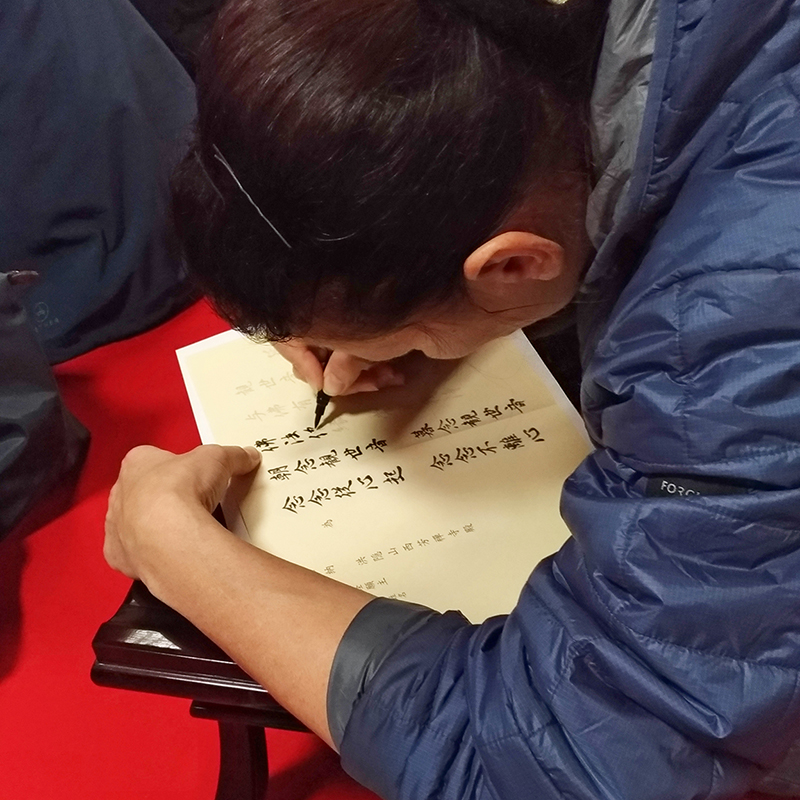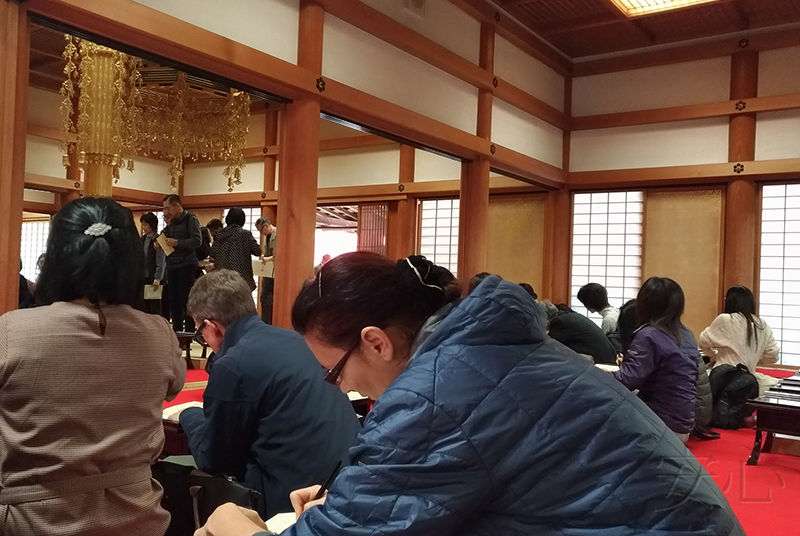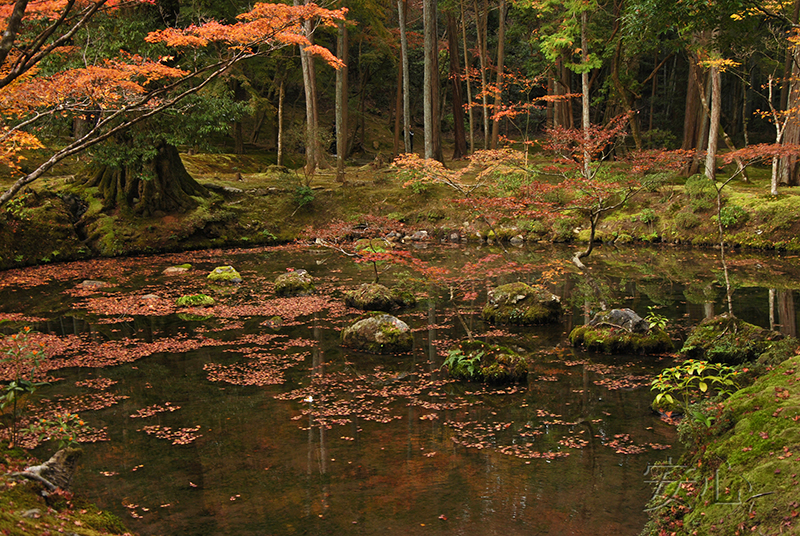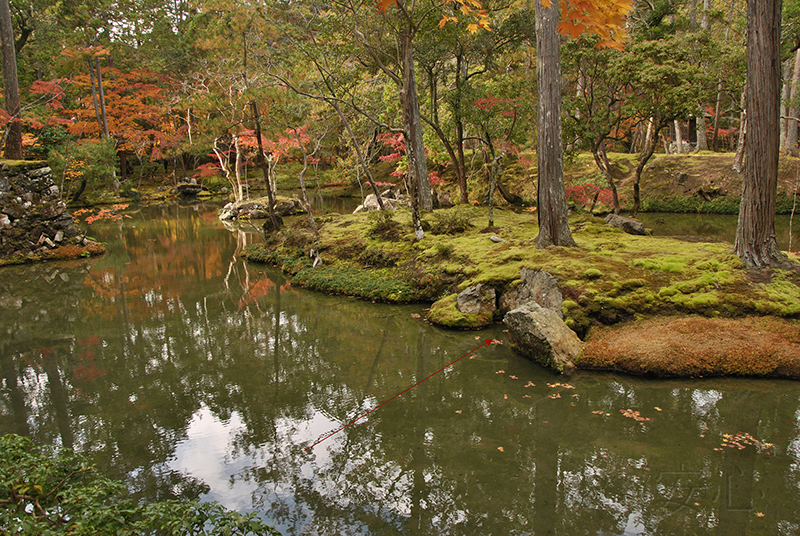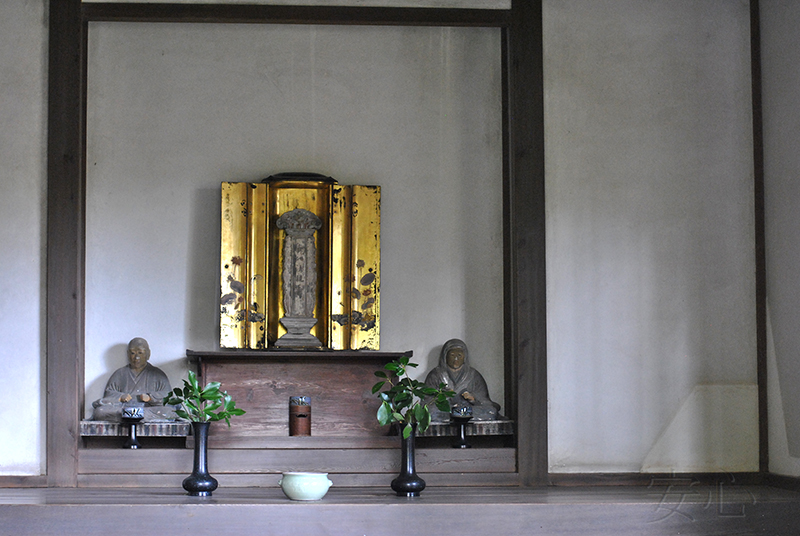
Saiho-ji garden
It was my dream to get to the Saiho-ji garden. This is one of the first Japanese gardens that I once saw on pictures on the net and it sunk into my soul. However, when I arrived to Kyoto, I found out that it is not so easy to visit this place. In the 50s, Saiho-ji Temple was experiencing a tourist boom, and the delicate moss covering the ground began to deteriorate. The monastery staff took steps to save the garden, but nothing helped. Therefore, since 1977, the temple can be visited only once a day, in groups with a certain number of people. Those wishing to get to Saiho-ji must first send a postcard to the monastery with a request for visit and wait for a response with the date when they are ready to receive you there.
It seemed to me that it would be easier to send a letter from Japan. So I did that. When I arrived to Tokyo, I found the post office, bought a special postcard with the stamp “ofuku hagaki” and sent it to the monastery, writing our names and dates when we would be in Kyoto. Ofuku hagaki is a set of two cards, the second one is for answering. As a return address, I wrote the address of the hotel where we booked accommodation, having warned them about this by mail.
There were seven days before our arrival in Kyoto, and we planned to stay there for ten. Everything worked out, and upon arrival at the hotel we received a response from the temple with the date of the visit.
For those wishing to send a postcard there is a link to the official website of the temple; there you can download the request form and address and read about the conditions.
At the appointed hour, we came to the entrance to Saiho-ji. It was closed, but our group had already gathered in front of the gate on the bridge.
In a couple of minutes we were allowed inside. We went along a wide road to the main temple.
At the time of the creation of the garden, this building did not exist; it appeared only in 1969. The area in front of the temple is covered with gray gravel; there are some green islets and small, very shallow pond. I think, in the warm season it is completely covered with plants. But at the end of November, the water was lowered, the plants were cut, and the pond looked more like a stone garden.
There is a reception room at the end of the temple. At the entrance you need to leave your shoes, then pay for entrance tickets and purchase special markers if you do not have it with you. Then for some time the members of our group were sitting on the covered veranda, waiting until everyone gets together.
When we all gathered, we were invited to go into the hall. The most agile took the best place on the open terrace, with European tables and chairs. The other people (including us) went inside. There were low tables, and we had to sit on the knees. Asians are used to sit like this, but Europeans usually feel not very comfortable. By the way, at first it seemed to me that we were the only Europeans, but in the hall we found that this was not so, there were three more couples in the group besides us.
We had to copy the ancient ten-phrase Kannon sutras onto tracing paper. Being a perfectionist, I started drawing hieroglyphs, trying to draw them beautifully.
Until I noticed that many people are already finished their work, while I have made only half!
I had to finish writing quickly, not really trying )) We signed our papers and put it on the common table. Then, as they say, the monks will collect all the copied sutras and pray for us.
After that, the most interesting part of the program began, we went to the garden. A long time ago, during the Asuka period, the villa of Prince Shotoku was located here. Later, in the Tempyo era (729–749 AD), the leading priest Gyoki Bosatsu, at the behest of Emperor Shomu, founded 49 temples in the central provinces. Saiho-ji was also built to store three images of the deity Amitabha, which are said to have been brought by Gyoki himself. Thus, Gyoki Bosatsu is considered the founder of Saiho-ji.
In 1338, the head priest of the nearby Shinto shrine Matsuo Taisha, Fujiwara Chikahide, imprisoned himself in the inner temple for prayer, so he got the revelation that he should ask the prominent Zen priest Muso Kokushi of the Rinsen-ji temple to be the head priest of Saiho-ji and to make its reconstruction. Muso Kokushi, who was also a leading garden master of the time, agreed and moved there. Saiho-ji originally meant "western temple". Muso Kokushi changed the ideogram, as a result the pronunciation was the same, but the middle character was changed. After that the name literally was translated as "sai" (west), "ho" (aroma) and "ji" (temple). Perhaps this name is due to the fact that earlier it was the Pure Land Paradise Garden, and Paradise, as it was believed, was in the West. Then Muso Kokushi redesigned the garden, giving it a touch of Zen. At the same time, the lower garden still remained in Paradise style, like a breeze, like a scent, like a memory. But this is just my free interpretation.
Muso Kokushi built several new buildings, but, unfortunately, they have not survived to this day. He also reconstructed the garden according to his own design.The garden is built on two levels: the upper one is in the karesansui style, the lower one is in the classical style with paths around the pond. As a rule, the visitors first go to the lower garden. We walked along the road, passing several residential buildings and the Kannon-do Temple. Before it used as the main temple until a new one was built.
Our attention was drawn to a pine tree formed by tiers. The lower branches likely will look as waves or wings in the future.
At the beginning of the lower garden is the small Shoando tea house, built in 1925. It is dedicated to the second son of the famous tea master Sen no Rikyu, Sen Shoan. His image, carved from wood, is also kept there.
Initially, the entire territory of the lower garden was covered with white sand. But over the years, the garden has experienced several floods (as a result of its location near the river) and periods of desolation after political uprisings and wars. As a result, it began to grow with moss. The monks did not interfere with this, and now more than 120 kind of beautiful emerald moss grow here, and they are carefully looked after. Nowadays Saiho-ji is widely known as Kokedera, or "Moss Temple".
The centerpiece of the lower garden is the pond. Although there are two ponds connected by a channel. The first one is small, called "Diamond Pond". Its main feature is several protruding stones arranged in two rows. There are two versions of their purpose. The first version indicates that these could be Yodomari-ishi, stones depicting sailboats anchored at night. These boats sail to the Penglai Island of Eternal Life (Japanese - Horai) in Chinese mythology. The second hypothesis is that they are the supporting stones of the gallery, which connected two pavilions built on opposite banks during the time of Muso Kokushi.
The main Golden Pond is built in the shape of the Chinese hieroglyph Shin, meaning "heart". There are three large and four small islands, four peninsulas. This garden was created during the Heian era as a "Pure Land Garden" Jodo. And, despite the fact that it was subsequently changed several times, including by Muso Kokushi, it retained the main features of the Garden of Paradise. In Saiho-ji, unlike the later temple gardens of Muromachi, visitors are still invited to discover the beauty of the garden during a leisurely stroll along the path around the lake and across small bridges to the islands.
In the lower garden, all the members of our group somehow imperceptibly disappeared. Although the pond is considered relatively small (at least compared to those created in the gardens of the Heian period), it has the magical property of making the visitor feel alone with nature. We walked, absorbing sounds and smells, enjoying the muted beauty of wet moss, diluted with bright splashes of autumn maple foliage, and it seemed that there was no one else next to us.
On the last island (Kasumi-jima) there is Sandzonseki, three stones representing the Buddhist triad. This triad has small size, what is very unusual. Here Sanzonseki can be easily missed if not known.
There is also a Turtle Island (Kame-jima). Most often pine trees are planted on it, but here the Turtle carries maples on its back.
Crane Island (Tsuru-jima) is slightly smaller. It is also look different from cranes in other gardens. Instead of stone wings, we see iris foliage and young maples.
Somewhere in the middle of the path there is the second teahouse Shonan-tei. It is believed to have been built by Muso Kokushi. Sen no Rikyu lived here for some time, until he received an order from Toyotomi Hideyoshi to commit ritual suicide (seppuku). Then, during the Keichyo era (1596-1615) Sen Shoan, Sen no Rikyu's second son, renovated the tea pavilion to his liking and lived there. Also, in 1862, this house served as a haven for the famous politician Iwakura Tomomi, who was hiding from the shogunate.
Shonan-tei is a small corner-shaped building. On the right is the soto-kosikake (waiting bench), and on the left is the moon-watching platform.
Usually, platforms for admiring the moon are built facing east. Here we see that it faces north. The fact is that from the teahouse it was supposed to admire the Moon through its reflection in the water.
Not far from Shonan-tei, in the middle of a green moss carpet, there is a stone tied with special rope (shimenawa). They say that once in this stone settled the deity-patron of the Matsuo shrine. It appeared to the abbot of Matsuo Taisha Shrine Fujiwara Chikahide and said that this is his place and asked not to build a temple here. The next morning the priest saw that the sacred rope on the stone was stretched.
The abbot fulfilled the request of the deity, didn't build a temple on this place, and the sacred rope on the stone is renewed annually.
In the lower garden there is also a third tea house, Tanhokutei. It was built in 1928 with the support of the late Mashimizu Zoroku, a ceramist, who was specially interested in this garden. It is a small building that houses the statue of Amitabha. Unfortunately, you cannot enter this tea house, but they say that the most beautiful view of the garden opens from the round window.
On the opposite bank you can see a small shrine. This is a repository.
At the end of the path, we saw a lonely boat. It is believed that Muso Kokushi planted seven bamboos next to it. But now there are more than seven. It is some kind of short, very graceful sort of bamboo and, apparently, not aggressive.
We reached the Kojokan gate. They means the first barrier where one led onward by one’s noble ambition must face many tests.
A steep climb begins behind the gate. This is the upper garden, whith stone compositions that considered the first examples of Japanese garden architecture, inspired by Zen Buddhism. Saiho-ji is by far the earliest extant example of karesansui, what literally means "dry landscape." Before this, the main focus in Japanese gardening art was a garden with a pond and islands. Here Muso Kokushi not only made stone compositions the main characters, but also reflected the spirituality of Zen in them.
Climbing the stairs, we found ourselves at the highest point of the garden with small pavilion built on the top. It is Shitoan, a hut for meditations built by Muso Kokushi in 1338.
Shitoan houses the burial tablets of Gyoki Bosatsu and Muso Kokushi, as well as wooden statues of Muso Kokushi and his wife.
Meditations were conducted not only in the hut, but also in the open air. For this Muso Kokushi created a stone composition with a special zazen stone on the left of Shitoan. But the main masterpiece of the garden is kare-taki, a dry three-tiered waterfall to the right of the hut. It starts at the top of the hill, reaches the middle, and shifts to the left. A flat stone covered with moss divides the stream in two. Then from the right side there is a branch to the right, thus balancing the entire composition.
On the left side there is a stone symbolizing carp. According to legend, a carp that managed to swim upstream and climb a waterfall becomes a Dragon.
We went back down the stone stairs leading to the main temple. Of course, I didn't want to leave this place!
Sometimes I think that the happiest people on earth are Japanese monks. Imagine, they have the opportunity to meet the dawn in this garden, to watch falling maple leaves in the fall, to catch the reflection of the Moon in the trembling surface of the pond, to touch the velvety moss crawling on stones and trees, to sit motionless on a warm stone, feeling the penetration of Space into the body and soul. Maybe in the next life we will be so lucky too?
Garden Information:
Address: 56 Matsuojingatanicho, Nishikyo Ward, Kyoto, 615-8286, Japan
anshin©2011All rights reserved. When using the materials of the site, reference is obligatory.
Proposals for co-operation, as well as comments and suggestions on the site please send to the address: anshinsad@gmail.comtel: +7 (965) 121-80-60, 10am-20pm








